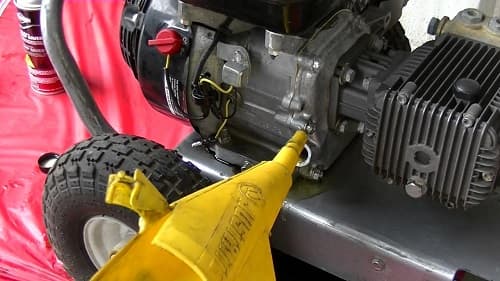Pressure washers are powerful, efficient cleaning machines used in various home and commercial applications, from light-duty cleaning to heavy-duty power washing. Maintaining your pressure washer is vital to achieving the best results and ensuring that your machine will last for years to come.
In this blog post, we will explore how to clean and maintain your pressure washer in order to keep it in peak condition. We will discuss why it is important to maintain your pressure washer, the steps to take to ensure its longevity, and the best practices for maintenance.

So, let’s get started with the signs indicating your pressure washer needs maintenance.
Common Signs that Indicate Your Pressure Washer Needs Maintenance
Loss of Pressure: If the pressure of the water coming out of the nozzle is lower than it should be, it could be an indication that the nozzle or hose is clogged or damaged.
Reduced Water Flow: If the water flow from the nozzle is weak or inconsistent, it could be a sign that the nozzle or hose is clogged or damaged.
Unusual Noises: If the pressure washer is making unusual noises, such as knocking or squealing, it could indicate a problem with the engine or pump.
Leaks: If you notice any leaks around the pressure washer, it could be a sign that there is a problem with the hoses or connections.
Difficulty Starting: If the pressure washer is having difficulty starting or staying running, it could be a sign that there is a problem with the air filter, oil, or spark plug.
Vibrations: If the pressure washer vibrates excessively, it could be a sign of a problem with the pump or the engine.
If you notice any of these signs, it is important to take the pressure washer in for maintenance as soon as possible to prevent further damage.
Cleaning and Maintenance of Pressure Washers
To get the best out of your pressure washer, you need to follow different types of maintenance procedures, which involves:
1. Turn off the Machine and Unplug It From the Power Source Before Cleaning.
This is a safety precaution to ensure that the machine cannot accidentally be turned on while you are cleaning it. This step is important as any accidental turning on can cause injury or damage to the machine.
2. Use a Brush or Cloth to Wipe Down the Exterior of the Machine.
This step helps to keep the machine looking clean and prevents dirt and debris from getting inside the machine and causing damage. It is recommended to use a mild detergent and water solution to clean the exterior of the machine. Be sure to dry the machine completely to prevent rust or other forms of damage.
3. Check the Nozzle for Blockages and Clean as Needed.
The nozzle is the small opening at the end of the wand that releases the high-pressure water. Blockages in the nozzle can reduce the pressure of the water and make it less effective at cleaning. To clean the pressure washer nozzle, remove it from the wand and use a small wire or toothpick to clear out any dirt or debris that may have accumulated inside. You can also use a nozzle cleaning solution to soak the nozzle for a few minutes before cleaning it.
4. Inspect the High-Pressure Hose for Any Leaks or Damage
The high-pressure hose carries the water from the pump to the nozzle. Leaks or damage to the hose can cause water to spray out in the wrong direction or reduce the pressure of the water. Check the hose for any kinks, cuts, or other signs of damage. If the hose is damaged, it should be replaced to ensure that the pressure washer is working properly.
5. Clean or Replace the Air Filter
A dirty air filter can restrict the airflow to the engine, causing it to overheat and potentially leading to damage. Therefore, it is essential to check the air filter regularly and clean or replace it as needed.
6. Drain the Detergent Tank and Flush It out With Clean Water
If the pressure washer has a built-in detergent tank, it should be drained and flushed out with clean water after each use. This will prevent the detergent from drying out and clogging the nozzle.
7. Check the Fuel and Oil Levels and Add Oil if Necessary.
This is the most crucial step if you use a gas pressure washer. Proper fuel and oil level in your pressure washer ensures it will function properly. The oil in a pressure washer lubricates the engine and helps to keep it running smoothly. Therefore, it is important to check the oil level regularly and add more if necessary.
But, if you are using an electric pressure washer, you can skip this step as they don’t run on fuel; instead, they use electricity or battery for their operation.
8. Consult the Owner’s Manual for Any Specific Maintenance Instructions for Your Particular Model.
Each pressure washer is different, so it is important to consult the owner’s manual for any specific maintenance instructions for your particular model.
9. Run it with Just Water After Each Use
It is also recommended to run the pressure washer with just water for a few minutes after each use to flush out any remaining dirt and debris from the pump and nozzles. This will help to prevent clogs and prolong the life of the machine.
10. Storage
Store the machine in a dry, clean place when not in use. This will help to prevent rust and other forms of damage to the machine.
By performing these regular maintenance tasks, you can ensure that your pressure washer is running at optimal performance and prolong its lifespan. Additionally, maintaining the pressure washer can help improve the efficiency of the machine and increase the effectiveness of cleaning tasks.
Read Next: Pressure Washer Safety Tips | How to Safely Use a Pressure Washer?